Design Elements of the Craftsman House
If traced far enough, the roots of Arts and Crafts homes began with Hindi bangalas, thatched roof cottages with porches and low, heavily overhung roofs. British officers occupying India in the late 19th century brought the Indian architecture to England and adapted it to build summer retreats known as bungalows.
Initially used as resort lodging in England, the bungalow style crossed the Atlantic and experienced a heyday in the early 1900s during the mass migration to California. With their low, extended roofs and shaded porches, bungalows were particularly suited to the warm climate; and Greene and Greene, two California architects, created designs that became hugely popular.
At the same time, Gustav Stickley was publishing his influential magazine, The Craftsman. Expounding the philosophy of the English Arts and Crafts movement, it advocated a revolt against the presumed evils of the Industrial Revolution – namely, mass-produced, shoddy goods – and espoused a return to honest, hand craftsmanship. Working with architect Harvey Ellis, Stickley (also an architect and a furniture maker) designed 221 house plans which he published in The Craftsman. Soon mail order companies like Montgomery Wards and Sears, Roebuck and Company made the homes affordable by selling complete kits that included all of the building components right down to the paint and finishing nails. Shipped by railcar, some 30,000 pre-milled and numbered pieces were delivered to a homeowner’s lot, along with a comprehensive instruction manual.
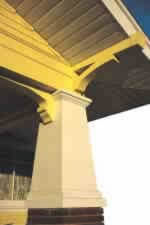
Regional Variations
The original Craftsman bungalows were generally modest homes with a single story or an abbreviated second floor with one or two bedrooms, commonly with sloping ceilings and dormer windows. They were a wide departure from the ornate elegance of Victorian design and were also more rugged than their English Arts and Crafts counterparts– appealing to our nation’s frontier history.
Wide porches were supported by simple rails or stocky, tapered columns atop brick or stone pedestals.
In true Craftsman style, this yellow ochre porch says WELCOME!
Stalwart proportions created a sense of stability and security. Wide porches were supported by simple rails or stocky, tapered columns atop brick or stone pedestals. Low slung, gabled roofs featured overhanging eaves. Walls were often divided into horizontal bands – brick or stone along the bottom, topped with combinations of stucco, split wood shingles and horizontal, vertical or shake siding. Wood elements framing the home, usually concealed in other architectural styles, were not only exposed but became celebrated, decorative details, as seen in brackets supporting roofs.
As the Arts and Crafts style spread across the country between 1905 and 1930, it was expressed in a wider variety to accommodate varying budgets and express regional differences.
In California, Texas and Florida, it frequently included elements inspired by Spanish missions – tile roofs; rounded arches, windows and doors; stucco walls with brick or masonry with rough-cut stones.
Frank Lloyd Wright and his school of Architects popularized the Prairie home in the Midwest. Typically two stories high, it featured a flat or low-hipped roof, alternating bands of brick and concrete, and art or beveled glass in doors and select windows. A relative of the Prairie home, the Foursquare or Box House became one of the most popular house styles in America. Its simple cube shape featured a front porch of varying dimensions and was topped with a hipped roof and a front roof dormer.
Windows were often grouped in pairs. Arts and Crafts homes were constructed in harmony with their landscape; wood materials were often painted or stained brown or dark green. They also utilized local materials. Consequently, these homes featured yellow brick in Chicago, dark red brick in Milwaukee, wood and brick in the North and shingle sheathed bays and gable ends in the Northeast.
Warm Interiors
In the late twentieth century, the Craftsman style, in particular, began enjoying a resurgence that is still going strong – with architects remodeling historic homes and design firms offering updated plans for new construction. Today’s homeowners are captivated by charming elevations evoking images of quiet, tree-lined streets and these homes’ warm, comfortable interiors. Compared to their Victorian predecessors’ stuffy, segregated rooms, Craftsman homes’ casual floor plans encourage informality and family togetherness.
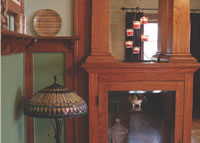
Double columns top display cabinets in this historic Craftman home.
Their efficient design makes them a highly practical choice as well. The long hallways and entryways found in Victorian homes were eliminated; in Craftsman Style Homes, family and friends pass from room to room directly.
Built-ins provide storage and make the most of available space. In historic Craftsman homes, living and dining rooms are divided by low display cabinets topped with tapered columns. There may also be a built-in sideboard in the dining room. Banquettes in kitchens and window seats in bedrooms provide picturesque seating and storage. Rear entries often include a mud room. Pocket doors add flexibility, allowing homeowners to combine or segregate spaces, closing a living room off from a foyer or dining room, or revealing additional sleeping, study or work spaces.
Another attribute that makes Craftsman design so popular in today’s market is its connection to nature. Most homes were positioned to greet the sun and surrounded by a generous garden. Large, shady front porches and sleeping porches in the rear blurred the distinctions between inside and outside living. An abundance of windows grouped in units of two or three brought in natural light and cross breezes.
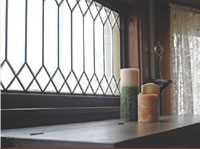
Sunlight streams through beveled, leaded glass windows – creating whimsical prisms on the dining room floor.
Windows themselves contribute to a Craftsman home’s charm and beauty. With the exception of clerestory windows located above built-in cabinetry, most of the windows are double hung with divided light panels in the upper sash and a large pane in the lower sash (providing a cleaner view). Selected windows in the front entry, living room and dining room feature sparkling, beveled glass or colorful, stained glass in geometric or botanical patterns.
Perhaps Craftsman homes are best known for their warm woodwork. Ceilings are trimmed with crown moldings, boxed beams, running beams or geometrically arranged moldings. Kitchens, bathrooms and porches feature tongue-and-groove paneling.
Living rooms sport built-in shelves or cabinets surrounding the fireplace and tapered pillars on top of display cabinets. Fireplace mantels and surrounds display unique, individualized details. In addition to built-in buffets or china cabinets, dining rooms often feature geometric paneling or wainscoting with wide caps (that double as display shelves). Picture rails and chair rails, generous baseboards and window trim all add character throughout the home.
Front entry doors are usually a focal point in and outside the home, from picturesque board-and-batten doors to a variety of panel configurations with art glass windows. In addition to pocket doors, interior doors include French doors with Prairie grid panes and doors with recessed or raised, vertical or horizontal panels; the most common being five horizontal recessed panels.
Originally, woodwork was oak, red pine, gumwood, fir or cypress. Higher end homes used quarter sawn oak. Wood was often exposed to ammonia fumes or stained in a dark finish to give it an aged patina. Influenced by the Neo-Colonial style, painted trim became more common by the 1920s, particularly in the South and Southwest. Warm colors and textures make homes cozy and inviting. In newer homes, walls may be faux painted to look like plaster work in saturated terra cottas, delicate sage greens and golden yellows. Lincrusta and anaglypta wallpapers (heavily embossed papers) can provide the look of tooled leather. Historically, walls were also covered with burlap, grass cloth or nature-inspired wallpapers.
Remodeling Challenges
With their unique, handcrafted charm, historic Craftsman homes can present some common challenges, including stripping and refinishing woodwork and undoing makeshift changes previous homeowners made that may have diminished the home’s original charm. Another major concern is space. Let’s face it. We have a lot more stuff today than families had in the early 1900’s: computers, electronics, microwaves and considerably more clothes. Easier updates include building a new closet in the corner of a bedroom, installing drawers under staircases and adding shelving at the end of a narrow hallway. Built-in cabinets and bookcases surrounding fireplaces may be modified to accommodate stereo equipment and a small television.
Creating extra space requires more extensive projects, such as: enclosing a sleeping porch to gain room for a master bedroom or bath, finishing off an attic or adding a second bath. Few original bungalows had a casual family room. One possible solution is to convert first-floor bedrooms into a family room and new kitchen and turn unfinished attic space into bedrooms.
One of the difficulties in remodeling is matching original woodwork. When adding on, the challenge is often finding space. Bungalows, in particular, were often built on tight lots, so the only way to add on is up. With their distinctively low roofs, it can be a challenge to raise the roof and maintain the home’s original character.
Two Craftsman Fans
Huge fans of the Craftsman home style, Chris and David Knight have lived in a home built in 1905 using a kit ordered from the Sears and Roebuck catalog and now reside in a home designed and built to their specifications.
“My husband and I both love antiques,” Chris Knight explains, “so I suppose it’s natural to appreciate Craftsman architectural details. Most of the windows in our previous home were leaded glass and the woodwork was amazing. A plate rail circled the entire dining room, which also had a built-in buffet. The dining and living rooms were divided by wood columns set on cabinets with leaded glass. The living room had a wood burning stove with leaded glass cabinets on both sides and a two-foot-wide mantle. There were also beautiful French doors leading to a three season porch.
“For a home of its age, it was in surprisingly good condition, but we did undertake some remodeling when we moved in. The previous owners had closed off half of the home’s sleeping porch. We restored it to its original dimensions, removed some paneling that had been added and had the walls re-plastered. We painted throughout the home, re-carpeted and refinished the parquet wood floors in the kitchen.
“When we relocated, we decided to build a new home incorporating many of the features we loved from our historic home. We didn’t want to be faced with replacing plumbing, electrical and HVAC systems. Our new home was actually built using Insulated Concrete Forms (ICFs), so it is extremely energy efficient.
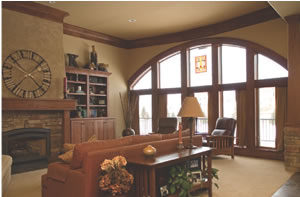 “Because we loved the warmth of our first Craftsman house, we recreated a lot of the woodwork in our new house. We have wood columns on top of glass-fronted cabinets at the entrance to our office (off the front entry). The fireplace in the great room is surrounded with built-in cabinetry. We included an updated, individualized touch by mirroring the exterior columns inside our entry. They’re tapered wood on top of stone pedestals. (The pedestals on the outside of the home are topped with stucco columns.)
“Because we loved the warmth of our first Craftsman house, we recreated a lot of the woodwork in our new house. We have wood columns on top of glass-fronted cabinets at the entrance to our office (off the front entry). The fireplace in the great room is surrounded with built-in cabinetry. We included an updated, individualized touch by mirroring the exterior columns inside our entry. They’re tapered wood on top of stone pedestals. (The pedestals on the outside of the home are topped with stucco columns.)
“Our personal tastes follow the ‘less is more’ approach, so we streamlined some of the details. Too much trim can make rooms look smaller and somewhat cluttered. I think we found a very peaceful compromise. Finally, we chose warm, fall colors for walls and furnishings.”
The Best of Old and New
“Building a new Craftsman house allows homeowners to enjoy traditional, architectural charm along with modern comfort,” notes Design Basics’ Custom Home Designer Marshall Wallman. “We can create more open floor plans, bigger rooms and larger closets. Rather than the historic eight to nine foot ceilings, we can incorporate ten foot ceilings. With beams or wood paneling, even cathedral ceilings can look at home in a new Craftsman home.
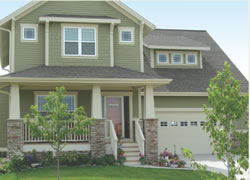 “It’s important to balance modern design with historic features. Even with an open floor plan, for example, you can define the rooms with an opening supported by columns or some short cabinets. In larger spaces, it’s important not to skimp on trim, since generous woodwork replicates the historic architecture and provides warmth.
“It’s important to balance modern design with historic features. Even with an open floor plan, for example, you can define the rooms with an opening supported by columns or some short cabinets. In larger spaces, it’s important not to skimp on trim, since generous woodwork replicates the historic architecture and provides warmth.
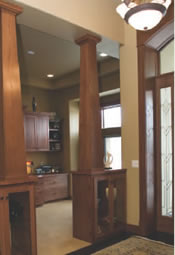 “Many of the homeowners I’ve worked with have chosen medium-tone maple or cherry woodwork to give their homes a lighter look. For those who prefer oak, I recommend either quarter sawn plywood or solid oak. Normal oak plywood often has a long, drawn out grain that repeats itself because it’s created with a rotary cut. Using an oil finish, instead of polyurethane, can also tone the grain down and provide a rich, aged look.“ Even with all of the modern appliances, it’s fairly easy to maintain the Craftsman feel in the kitchen. I often use recessed panel cabinet doors and cover the floors with wood or a slate tile; I’ve also seen linoleum or cork used effectively.
“Many of the homeowners I’ve worked with have chosen medium-tone maple or cherry woodwork to give their homes a lighter look. For those who prefer oak, I recommend either quarter sawn plywood or solid oak. Normal oak plywood often has a long, drawn out grain that repeats itself because it’s created with a rotary cut. Using an oil finish, instead of polyurethane, can also tone the grain down and provide a rich, aged look.“ Even with all of the modern appliances, it’s fairly easy to maintain the Craftsman feel in the kitchen. I often use recessed panel cabinet doors and cover the floors with wood or a slate tile; I’ve also seen linoleum or cork used effectively.
“In the bathroom, it can be tricky to achieve a historic look and still provide all of the storage we require today. In one home, I placed a nice storage cabinet between two pedestal sinks and put mirrored cabinets above the sinks. That bath also had a free-standing tub, white subway tile on the walls and white hexagonal tiles on the floor. Traditionally, baths in Craftsman homes used a lot of white because it created a sense of cleanliness.
“Ironically, Craftsman homes originally came about in protest of mass-produced goods but today’s modern technology makes replicating the style easier and more affordable,” observes Wallman. “For instance, cultured stone is available at a fraction of the cost of real stone. If you’re looking for low maintenance, James Hardie® fiber cement siding comes in vertical, horizontal and shingle styles – and looks more like real wood and stucco than similar vinyl products. There are a variety of authentic looking shingles available, from shake composites to attractive asphalt shingles. Many of the major window and door manufacturers have Craftsman lines, including Andersen, Pella and Marvin.
“The Internet makes research easier and provides instant access to resources all over the country. One of my favorite sites for period lighting and hardware is www.Rejuvenation.com. Kichyyler® Lighting also has an extensive new line of Tiffany fixtures. Sites such as www.CraftHome.com and www.Craftsmanhome.com offer everything from door knobs, mail slots and heat registers to tiles, towel bars and ceiling fans.”
With its unpretentious, time-honored elements, solid sense of security and cozy atmosphere, the Craftsman home has become an American classic that adds character to any neighborhood.
